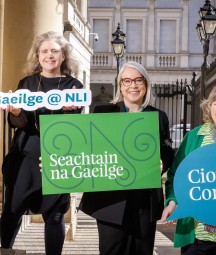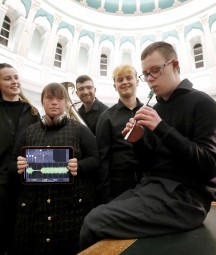The exhibition captures the social, cultural and technological changes that have taken place across Ireland from the middle of the 19th century up to the turn of this century, and has a number of photos charting Cork life.
The exhibition offers unique glimpses into Irish history and ordinary Irish lives, as well the evolution of photography, including a snapshot of women in the 1860s selling refreshments in Killarney, and a remarkable shot of a passing steam train in Clones, Co Monaghan in 1959.
The exhibition comprises 50 photographs taken between 1858–2001, representing the age of analogue photography in Ireland. Photographs on display include early forms such as salt paper print and stereo-pair up to more contemporary photography.
One image captures an idyllic street scene in the village of Leap, Co Cork taken around 1900–1920. The photographer, Fergus O'Connor, was a Dublin publisher who published Sean O'Casey's early writings and produced nationalist postcards and related material. Following the Easter Rising, he was imprisoned in Lewes prison. The image is a glass plate negative, 17 x 22 cm.
Another photograph is of a family group featuring eight people, and is part of The Poole Photographic Collection. The photograph was a commissioned portrait by J.J. Healy Esq. G.P., of Queenstown, Co Cork and was taken on 27 May 1916.
A very different photograph in the exhibition from Cork is that of the Construction of the new lighthouse, Fastnet Rock around 1902. The original Fastnet lighthouse, built in the 1850’s, was not robust enough for its exposed position, and construction of its replacement began in 1897. Blocks of Cornish granite were delivered by boat and then transported by a tramway and a pulley system to build the tallest, and widest, lighthouse in Ireland and Great Britain.
Commenting, Acting Head of Exhibitions, Learning and Programming at the NLI and curator of this exhibition, Sara Smyth said:
“What’s collected today becomes history tomorrow. As Ireland’s memory-keeper, the NLI continues to collect and share a vibrant national collection that documents historical and contemporary life on the island of Ireland. The NLI houses over five million photographs, which are a visual record of the history and culture of Ireland.
“The exhibition will run until 2025 and phase one will feature framed photographs from 20 of our most popular collections. The images selected speak to the diversity of Ireland, with photographs representing almost every county, North and South of the Border.
“We highlight working-class and middle-class communities; women, who usually appear less often than men in history telling; and we juxtaposition rural communities alongside their urban counterparts. Themes, such as climate change and transport, are also addressed.”
Join the exhibition’s curator, Sara Smyth, for a free tour of the exhibition over the summer, with the next monthly tour on Thursday 17th August from 1.00-1.40pm, no booking required.
If you are in Dublin with friends, family or by yourself you can pop into the free and accessible People and Places exhibition 10am–4pm Monday to Sunday, with last admission 3.30pm.
To discover more photographs from the NLI’s vast collections, go to www.nli.ie.
ENDS


